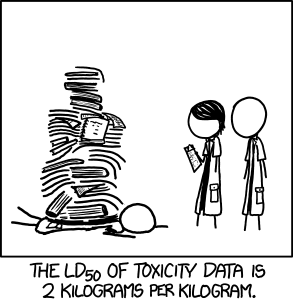Toxicology is defined by Merriam-Webster Dictionary as a science that deals with poisons,
their effects, and the problems associated with them. These problems can
include clinical, industrial and legal related problems. Basically, toxicology studies
poisonous chemicals and reactions to them; therefore, a person who studies these
poisons is considered a toxicologist. The different branches of toxicology
include clinical toxicology, pharmacology, forensics, and OSHA aspects.
The chemicals studied by toxicologists have four major routes of entry into the human body. These routes
include inhalation, absorption, ingestion, and injection. Inhalation is to be
breathed in through the lungs. Absorption is through skin contact. Ingestion is
when something is eaten through the mouth. And injection is typically performed
with a needle into the skin.
Inhalation is the most common entryway for chemicals in the
workplace. Injection is less likely to happen unintentionally at the workplace
given how specific the entryway is.
Irrelevant of how the chemical or drug entered the body, the
distribution of the chemical into the body is the same. To remove the hazard
from the area, try to isolate the hazard and provide a local exhaust. If that
is not possible, help the exposed workers fewer shifts to minimize impact.
Biotransformation is the chemical changes made by an organism on a chemical compound. There are
two different phases involved in biotransformation. Phase I involves oxidation,
reduction and hydrolysis reactions. Oxidation is when electrons are released
(ex: rust). Reduction is when oxygen is removed from the compound, and
hydrolysis is a reaction involving a bond breaking due to water. This occurs
mainly between an ion and water molecules. These three reactions make up phase
I work to convert the original compound into a more polar metabolite. Phase II
involves conjugation reactions. These reactions result in the formation of
water-soluble compounds. Different ages of life change which phase the body
metabolizes with typically.
The medical definition of Dose-Response explains that dose-response is the pattern of which your body responds to varying
dosages of a chemical or drug. For example, nicotine, cocaine, morphine, and
other amphetamines dose-response curves are similar.
In toxicology, the median lethal dose is 50%, commonly
abbreviated as LD50. This percentage is referring to the time when 50% of the
animals in a group of test animals dies. It is a method to measure the acute
toxicity of a material. This is not to be confused with LC50, meaning lethal
concentration in the air or in water. Chemicals have a broad range of effects
on our health. Toxicity tests are useful in many situations to help prevent
overexposure.
Toxicity is influenced by many different factors. The
dosage, exposure route, and absorption ability influence toxicity, as well as
the injesting person’s life stage, metabolism, gender, health, and nutritional
status. Pregnant women’s toxicity is influenced differently than that of a
non-pregnant woman as well.
In some cases, reactions to chemicals or drugs are completely
abnormal and unpredicted, (formally called idiosyncratic responses). This can
happen because of genetic predispositions or immune system issues or anything
in between. These reactions could be abnormally extreme or the opposite.

